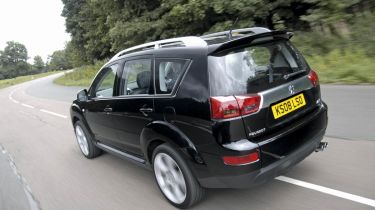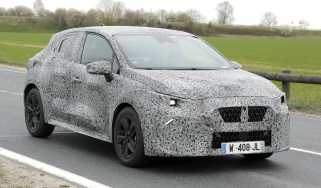Peugeot 4007 Irmscher
Sporty add-ons build on strengths of French seven-seater.
With a long history of producing high-performance hatchbacks, Peugeot knows more about hot models than it does off-roaders. But having joined forces with 4x4 specialist Mitsubishi to produce with the 4007, it’s time for the company to turn up the heat on its SUV.
And the new Irmscher Sport Pack really helps to differentiate the French model from the Japanese firm’s Outlander. Costing £705, the kit beefs up the looks with twin exhaust tailpipes, front and rear spoilers and 19-inch wheels.
The suspension has been left alone, though – and this is soon apparent out on the road, where the ride is more compliant than the Toyota’s, even though the Peugeot has those huge alloys. Progress is smoother in town and on the motorway, although the 4007 still generates more road noise at high speeds than the refined RAV4.
So the Peugeot scores on comfort, but on a challenging road it appears less at home than the smaller, nimbler Toyota. While it’s far from disgraced, the 4007 feels slightly cumbersome through dips and over crests. With a clunkier gearchange and a more agricultural diesel rattle than the RAV4, it reminds you of an old-school off-roader when driven quickly.
A button on the centre console allows you to switch between two and four-wheel-drive modes. Choose the former, and the steering wheel writhes in your hands under hard acceleration; this is better contained in the 4WD setting.
As it has less power, we expected the big Peugeot to trail the Toyota against the clock. But from 0-60mph, it was only four-tenths-of-a-second behind, completing the dash in 10.1 seconds. It wasn’t slow through the ratios, either, matching the 4.1 seconds it took the RAV4 to cover 30-50mph in third.
It also scores heavily for practicality. There are stowage cubbies everywhere, with two gloveboxes, as well as bins in the dash top, centre console and armrest, making it a viable MPV alternative. Overall, the interior is attractive and uncluttered, although as in the Toyota, there are hard, black, childproof plastics wherever you look. But the build quality feels better than in the Japanese car.
As with the RAV4, the rear seat slides back and forth, and the ample legroom means you can take advantage of this facility even when you’re carrying tall passengers. There are more tricks in the luggage area: the third row of seats rises up from the boot floor, although this involves a fiddly arrangement of three pulleys.
Once it’s in place, there is plenty of space for small children, while adults can squeeze in for short trips. Accessing this final row is easy: provided no one is in the middle bench, you simply press a button inside the boot and the seats fold and flip forward. And even with the third row in use, there’s some luggage space left, too.
The Peugeot clearly has a broad range of talents. It’s just a question of whether the blend of practicality and sporty looks gives the 4007 the edge in this test.
Details
Price: £23,700
Model tested: Peugeot 4007 Irmscher
Chart position: 1
WHY: It looks the part with its Irmscher add-ons, but is the 4007 a better car to drive?
Economy
Costing £23,700 in sporty Irmscher trim, the 4007 certainly gives you a lot of metal for your money. Standard equipment includes electric folding, heated door mirrors and, of course, the all-important third row of seats. If you want leather, xenon headlamps, rear parking sensors and a CD autochanger, you should consider upgrading from SE to GT spec for £3,300 extra. Emissions of 191g/km place the Peugeot in band F, meaning annual road tax is £210. Company car users pay £1,375 a year if they earn at the standard rate, or £2,749 per year on the higher rate. Either way, you can save by going for the standard 4007.






